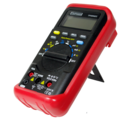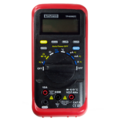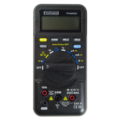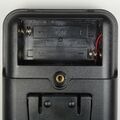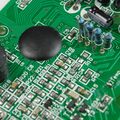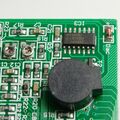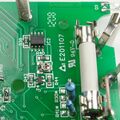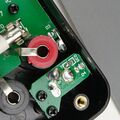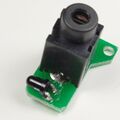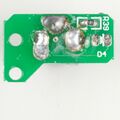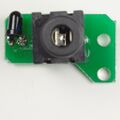Difference between revisions of "TekPower TP4000ZC"
Jump to navigation
Jump to search
| (16 intermediate revisions by 2 users not shown) | |||
| Line 1: | Line 1: | ||
[[File: | {{Infobox multimeter | ||
| image = [[File:Tp4000zc_front.png|180px]] | |||
| name = TekPower TP4000ZC | |||
| status = supported | |||
| source_code_dir = serial-dmm | |||
| counts = 4000 | |||
| categories = CAT II (600V) | |||
| connectivity = [[Device_cables#Digitek_DT4000ZC_cable|RS232]] | |||
| measurements = voltage, resistance, continuity, diode, capacitance, frequency, temperature, current, duty cycle | |||
| features = autorange, data hold, relative | |||
| website = [http://www.tekpower.us tekpower.us] | |||
}} | |||
The TekPower TP4000ZC is a 4000 counts, CAT II (600V) handheld digital multimeter with RS232 connectivity. | The '''TekPower TP4000ZC''' is a 4000 counts, CAT II (600V) handheld digital multimeter with RS232 connectivity. | ||
This multimeter | |||
This multimeter is a rebadged [[Digitek DT4000ZC]]. | |||
== Hardware == | == Hardware == | ||
* The microcontroller is an unidentifiable plastic blob | '''Multimeter:''' | ||
* '''Multimeter IC''': The microcontroller is an unidentifiable plastic blob (based on the communication protocol, probably a [[Multimeter_ICs#Fortune_Semiconductor_FS9721_LP3|Fortune Semiconductor FS9721_LP3]]) | |||
* LM358 opamp | * LM358 opamp | ||
* HEF4013BT flip-flop | * HEF4013BT flip-flop | ||
* The RS-232 connector is a standard 3.5m stereo jack, with the ring left unconnected. The transmitter is optically insulated from the rest of the device. | |||
'''Cable:''' | |||
* See [[Device_cables#Digitek_DT4000ZC_cable]]. | |||
* The DB-9 connector has a loopback resistor between the RX and TX pins. | |||
== Photos == | == Photos == | ||
'''Multimeter:''' | |||
<gallery> | <gallery> | ||
| Line 34: | Line 54: | ||
File:Tp4000zc_232_pcb_back.jpg|<small>RS-232 PCB, bottom</small> | File:Tp4000zc_232_pcb_back.jpg|<small>RS-232 PCB, bottom</small> | ||
File:Tp4000zc_232_pcb_front.jpg|<small>RS-232 PCB, top</small> | File:Tp4000zc_232_pcb_front.jpg|<small>RS-232 PCB, top</small> | ||
</gallery> | </gallery> | ||
'''Cable:''' | |||
See [[Device_cables#Digitek_DT4000ZC_cable]]. | |||
=== | == Protocol == | ||
See [[Multimeter_ICs#Fortune_Semiconductor_FS9721_LP3]]. | |||
User bit 2 is used to indicate temperature measurement in degrees Celsius. | |||
== Resources == | == Resources == | ||
| Line 178: | Line 71: | ||
* [http://www.youtube.com/watch?v=7pbRLom7bNc Video review of TP4000ZC (Part 2/2)] | * [http://www.youtube.com/watch?v=7pbRLom7bNc Video review of TP4000ZC (Part 2/2)] | ||
* [http://www.multimeterwarehouse.com/TP4000ZC/TP4000ZC_serial_protocol.pdf TP4000ZC serial protocol] | * [http://www.multimeterwarehouse.com/TP4000ZC/TP4000ZC_serial_protocol.pdf TP4000ZC serial protocol] | ||
* [http://www.multimeterwarehouse.com/TP4000ZC.htm multimeterwarehouse.com: TP4000ZC] | |||
* [http://www.multimeterreviews.com/tekpower-tp4000zc-pc-based-rs232-interaced-auto-ranging-digital/ multimeterreviews.com: TekPower TP4000ZC (PC RS232 Interface)] | |||
* [http://mjlorton.com/forum/index.php?topic=103.0 mjlorton.com: T4D 22 TekPower TP4000ZC] | |||
[[Category:Device]] | [[Category:Device]] | ||
[[Category:Multimeter]] | [[Category:Multimeter]] | ||
[[Category:Supported]] | |||
Latest revision as of 23:12, 21 January 2013
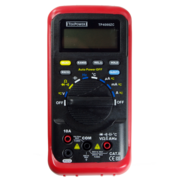 | |
| Status | supported |
|---|---|
| Source code | serial-dmm |
| Counts | 4000 |
| IEC 61010-1 | CAT II (600V) |
| Connectivity | RS232 |
| Measurements | voltage, resistance, continuity, diode, capacitance, frequency, temperature, current, duty cycle |
| Features | autorange, data hold, relative |
| Website | tekpower.us |
The TekPower TP4000ZC is a 4000 counts, CAT II (600V) handheld digital multimeter with RS232 connectivity.
This multimeter is a rebadged Digitek DT4000ZC.
Hardware
Multimeter:
- Multimeter IC: The microcontroller is an unidentifiable plastic blob (based on the communication protocol, probably a Fortune Semiconductor FS9721_LP3)
- LM358 opamp
- HEF4013BT flip-flop
- The RS-232 connector is a standard 3.5m stereo jack, with the ring left unconnected. The transmitter is optically insulated from the rest of the device.
Cable:
- See Device_cables#Digitek_DT4000ZC_cable.
- The DB-9 connector has a loopback resistor between the RX and TX pins.
Photos
Multimeter:
Cable:
See Device_cables#Digitek_DT4000ZC_cable.
Protocol
See Multimeter_ICs#Fortune_Semiconductor_FS9721_LP3.
User bit 2 is used to indicate temperature measurement in degrees Celsius.
